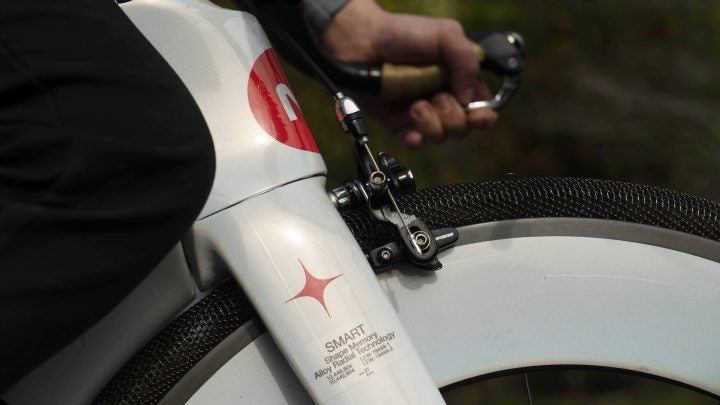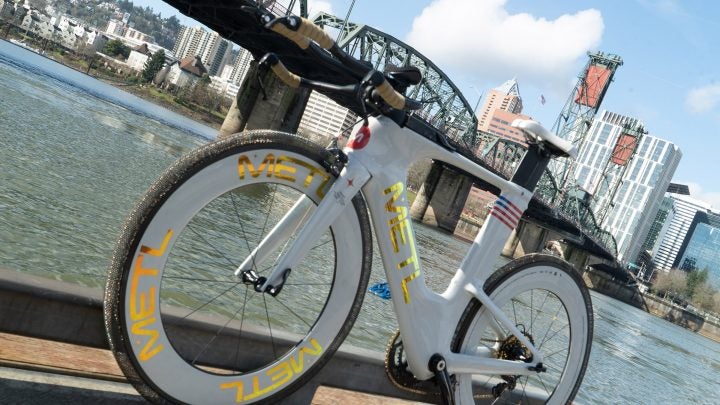New perk! Get after it with local recommendations just for you. Discover nearby events, routes out your door, and hidden gems when you sign up for the Local Running Drop.
The next time you check in on the latest development of the Mars Exploration Rovers as they explore the Red Planet, take a moment to check out their wheels. The same technology that allows Rover tires to travel over rocks, divots, and cracks without puncture could soon be the thing that keeps you from going flat on your next training ride.
The Superelastic Tire, as it’s known by NASA, is an airless tire that is flexible like rubber, but can’t be punctured. Made of a nickel-titanium blend called Nitinol, the Superelastic Tire works on a variety of terrain without the threat of puncture or pinching—critical when traveling on a planet where no one is around to change a flat tire.
RELATED: “Vittoria Air-Liner Road designed for riding a flat tire with a foam liner” from VeloNews
While working on the Superelastic Tire as a summer intern at NASA, engineer Calvin Young began to wonder if the airless tire could be useful on Earth; particularly, to stop flat tires on his road bike. In 2018, he developed a prototype for his own bike, and by 2020, his space-age bicycle tire had become its own company: SMART Tire, an acronym for Shape Memory Alloy Radial Technology.

The company’s first airless bike tire, named METL, takes the Nitinol material of the Mars Rover project and coats it with a proprietary rubber-like material known as Polyurethanium, and it aims to literally reinvent the wheel by creating a bike tire that eliminates the need for replacement tubes and tires. It will never be underinflated when it rolls out for a long ride, or blow out on a screaming downhill. The structure of the tire—created from interlocking springs—provides the same traction and shock-absorbing capabilities as pneumatic tires without losing structural integrity over time.
“When we say one tire for the life of your bike, we mean it,” said Brian Yennie, Founder and Chief Technology Officer at SMART Tire. “Tires shouldn’t be disposable, and they don’t have to be.”
Yennie expects the tires to first take off in gravel, mountain, and commuter bike applications, where a more robust tire is preferred and tire weight is less of a concern. “For the gravel, mountain and eBike applications, you can expect weight comparable to an average, top-selling tire in that category,” Yennie said.
But roadies and triathletes might also find value in a slightly heavier tire for training—especially if it means shedding weight elsewhere, like in a flat kit, for instance. As SMART moves from general purpose applications to more extreme ones, they expect to naturally pick up more high-performance athletes. “You won’t be seeing a sub-300 gram road tire anytime soon, but the total weight of the [SMART] system is a lot less than people typically assume,” Yennie said. “While any sort of metal structure obviously adds weight, we also don’t need structural support from sidewalls, there are no valves, no tubes, no extra sealants, repair kits. All of that savings, and the fact that it’s a strong material and a hollow structure, really adds up.”
The SMART Tire can be a difficult concept to grasp, especially for gearheads who obsess over tire pressure or rolling resistance to the tiniest unit of measurement. The tire is not inflated, but it’s also not a solid tire, so apples-to-apples comparisons are difficult to make against a traditional pneumatic tire or solid rubber tire. It also sounds a little crazy to people—because it’s so different, it’s easy to dismiss the SMART Tire as no more than a space-age gimmick.
“People are going to be skeptical until they can try it, and we understand that,” Yennie said.
Currently, the SMART Tire expects its first METL bike products to be publicly available in 2022. In the future, it hopes to bring even more innovation to bike tires, and is looking at features like adjustable pneumatic pressure. “We expect to continuously improve the product over the next several years as we learn more and more about the capabilities,” Yennie said. “I think there are many years to come where someone is going to squeeze another 5% out of this, or 10% out of that…it should be an interesting ride.”

